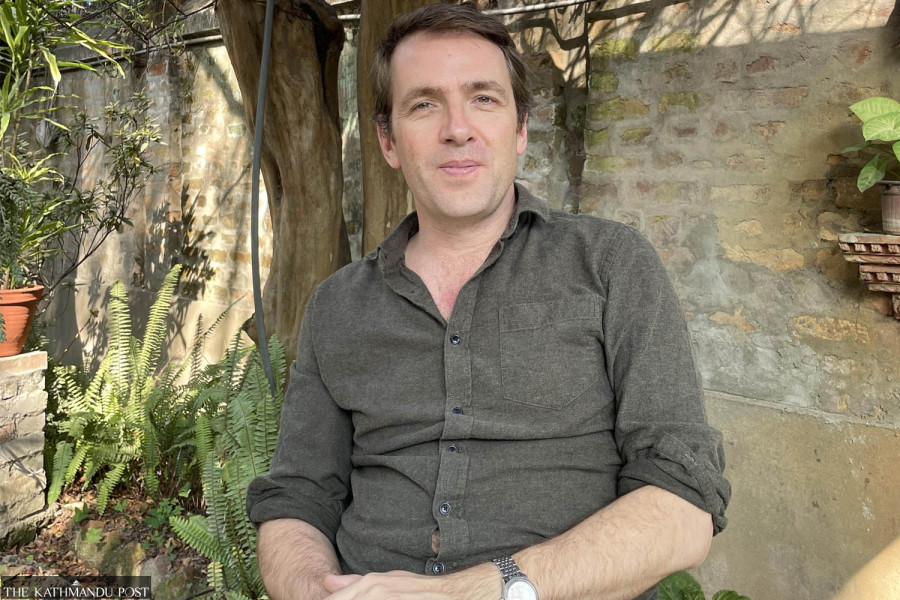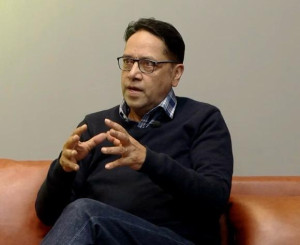Books
Telling Nepal’s story
English writer and journalist Thomas Bell discusses coming to Nepal two decades ago, the state of contemporary journalism and his new book ‘Human Nature’.
Anish Ghimire
Thomas Bell is a man of few words. When we decided to meet at Cafe Cheeno in Patandhoka following the launch of his book, ‘Human Nature’, I expected our conversation to last for an hour, but we were done within twenty minutes.
Bell studied at the University of Oxford and the Courtauld Institute of Art in London. Fresh from graduation, he came to Kathmandu for the first time in 2002 as an international correspondent to cover the ongoing civil war. He ended up staying longer than he would have imagined—eighteen years. His books, ‘Kathmandu’ (2014) and ‘Human Nature’ (2024), result from his in-depth reporting, travels and research on Nepal and the Nepali people.
Currently living in the UK, Bell, a former South East Asia correspondent for the UK Daily Telegraph, is more inclined towards books than journalism. In this chat with the Post’s Anish Ghimire, Bell discusses coming to Nepal, the state of contemporary journalism and his new book ‘Human Nature’.
Have you always wanted to be a journalist?
Not exactly. After I finished university, I began looking around, thinking about what I should do, and journalism seemed like it would combine a few things I was interested in: politics, travel, and writing. So it was a choice I made later.
What made you come to Nepal during a difficult period and write ‘Kathmandu’?
Well, I came here because it was a difficult period. I had recently graduated in history and wanted to be a foreign correspondent. So, I looked around, considered a few options, and chose Nepal. It felt like the right option because of what was happening in the country.
Right after the royal massacre, the Maoists were making progress in the countryside, and the world was paying attention to Nepal. It seemed like a nice place to travel around as well. The country grew on me, and I ended up staying for about eighteen years.
How did your time in Nepal shape your understanding of the complex relationship between the country’s history, culture and politics?
I was primed to think about those relationships because of what I studied at the university. Alongside a degree in history, I also acquired another degree in architectural history. So, writing about it came naturally. Plus, I was interested in learning about the country’s culture, politics, and architecture. I dug deeper to write about how the streets, the squares, the chowks, and the buildings worked together.
I have done something similar with the new book, ‘Human Nature’, but instead of built-in environments, it’s about the hills, mountains, forests, and rivers.
You’ve been in journalism for a long time, having worked for the Economist and The Daily Telegraph. How has journalism changed since you arrived in Nepal for the first time?
Journalism around the world has changed a lot. Today, there is a lot less money in it. When I started, Nepal was going through a difficult period, and there were plenty of stories to report. A young man like me could make a decent living abroad because newspapers paid my freelance work a modest amount.
However, that is not the case anymore because of industry changes and the emergence of the internet. The media worldwide lacks resources, and people get their news by other means.
Another big difference is when I first came here, a few Nepali journalists reported in English for foreign media. Now, that space is filled up by many local reporters who can do much better than an outsider. So, that’s good progress.
Some of the changes in the industry brought about by the internet have also affected the domestic media landscape here. Newspapers are struggling for business. For the last few days, I have been trying to find newspapers in the market; there weren’t many shops selling them.
Your new book, ‘Human Nature’, explores Nepal’s history. What aspect of the country do you believe is most misunderstood?
This book looks at Nepal’s history but from a particular lens—in terms of the relationships between society, culture, and the environment. So, it’s kind of an environmental history. Something that might be new to the readers is the discussion of the role of agriculture.
Prithvi Narayan Shah is celebrated as a military and political genius who rose from the micro-kingdom of Gorkha to unify Nepal. By his death in 1775, he had conquered the Kathmandu Valley and established it as his capital. He laid the foundation for the Gorkhali Empire, which briefly spanned the Himalayas from Sikkim to Punjab.
His success is often attributed to his strategic brilliance and patriotic vision, portraying him as a unifier of a fragmented land. A key aspect of his strategy was rewarding soldiers with land, creating a land-military system that fueled his empire’s expansion.
However, this narrative is intertwined with a more profound history: the rise of agriculture, particularly rice farming. Rice cultivation had been spreading eastward in Nepal long before King Shah’s time, fostering the growth of small kingdoms. Unlike foraging or pastoralism, rice farming produced surplus food, which brought about taxation and the establishment of villages, kings, laws, and temples.
This agricultural transformation necessitated greater social and military organisation, creating the conditions for unification. King Shah and his successors finalised this process, consolidating the numerous ‘rice kingdoms’ into a single nation, completing a centuries-long evolution of agrarian society into a centralised state.
How similar or different is writing a piece and writing a book?
I don’t do much journalism these days. The only writing I do is for my books, which come out occasionally. But yeah, the writing process is very different. Writing a short piece is merely a thousand words, whereas a book is about eighty thousand words. The difference is like running a marathon and a sprint, I guess.
Thomas Bell’s book recommendations
The Cat’s Table
Author: Michael Ondaatje
Publisher: Vintage
Year: 2011
Ondaatje’s novels are extraordinary, and this is probably my favourite. It’s about a boy’s journey on a large ship’s three-week voyage.
The Wayward Daughter
Author: Shradha Ghale
Publisher: Speaking Tiger Books
Year: 2018
The book convincingly captures the journey of a middle-class girl growing up in Kathmandu during the Nepali civil war.
Changes in the Land
Author: William Cronon
Publisher: Hill and Wang
Year: 1983
It’s a remarkable work that provides a slim environmental history of the encounter between Native Americans and New England settlers.
Crow
Author: Ted Hughes
Publisher: Faber and Faber
Year: 1970
Hughes’s book is a dark and brilliant anthology of poems telling how God and a crow created the world.
Beyond a Boundary
Author: CLR James
Publisher: Hutchinson
Year: 1963
The famous Trinidadian Marxist historian was into cricket. This is his masterpiece on colonialism and the sport.




 6.12°C Kathmandu
6.12°C Kathmandu











